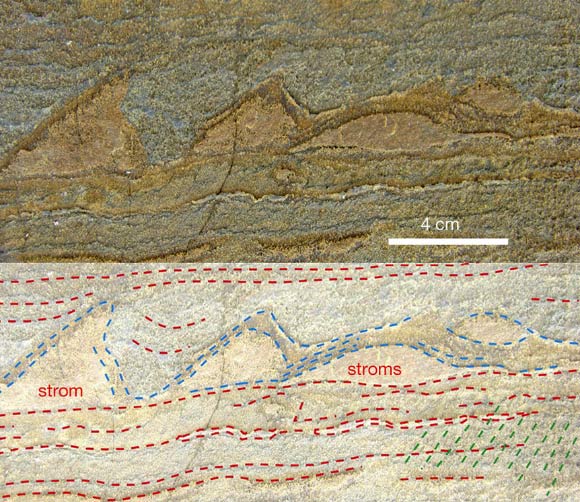An international team of scientists from Australia and the UK has uncovered the world’s oldest fossils in a remote area of Greenland, revealing that microbial life thrived on our planet 3.7 billion years ago.

3.7-billion-year-old Isua stromatolites: isolated stromatolite (strom) and aggregate of stromatolites (stroms); locally, lamination is preserved in the stromatolites (blue lines); layering in the overlying sediment (red lines) onlaps onto the stromatolite sides; a weak tectonic foliation is indicated (green lines). Image credit: Allen P. Nutman et al.
The team, headed by University of Wollongong’s Professor Allen Nutman, discovered 3.7-billion-year-old stromatolite fossils in the Isua Greenstone Belt (Isua supracrustal belt, or ISB) along the edge of Greenland’s icecap.
“We report evidence for ancient life from a newly exposed outcrop of 3.7-billion-year-old metacarbonate rocks in the ISB that contain 1-4 cm-high stromatolites, macroscopically layered structures produced by microbial communities,” the scientists said.
“This indicates that as long as 3.7 billion years ago microbial life was already diverse,” Prof. Nutman added. “This diversity shows that life emerged within the first few hundred millions years of Earth’s existence, which is in keeping with biologists’ calculations showing the great antiquity of life’s genetic code.”
Stromatolite fossils are the most persistent evidence of life in Earth history, and are known from the present (for example, Shark Bay, Western Australia) to 3.48 billion years ago in the rock record.
“The significance of stromatolites is that not only do they provide obvious evidence of ancient life that is visible with the naked eye, but that they are complex ecosystems,” Prof. Nutman said.
The Isua stromatolite fossils predate by 220 million years the previous most convincing and generally accepted evidence for oldest life remains in the 3.48-billion-year-old Dresser Formation in the Pilbara region of Western Australia.
The Isua stromatolites – exposed by the recent melting of a perennial snow patch – were shown to have grown in a shallow marine setting, providing the first evidence of an environment in which early life thrived.
“The ISB stromatolites grew in a shallow marine environment, as indicated by seawater-like rare-earth element plus yttrium trace element signatures of the metacarbonates, and by interlayered detrital sedimentary rocks with cross-lamination and storm-wave generated breccias,” Prof. Nutman and co-authors explained.
“This discovery turns the study of planetary habitability on its head,” said co-lead investigator Dr. Vickie Bennett, of the Australian National University.
“Rather than speculating about potential early environments, for the first time we have rocks that we know record the conditions and environments that sustained early life.”
“Our research will provide new insights into chemical cycles and rock-water-microbe interactions on a young planet.”
“It was a groundbreaking find that could point to similar life structures on Mars, which 3.7 billion years ago was a damp environment,” said co-author Prof. Martin Van Kranendonk, of the University of New South Wales.
“The structures and geochemistry from newly exposed outcrops in Greenland display all of the features used in younger rocks to argue for a biological origin,” he said.
“This discovery represents a new benchmark for the oldest preserved evidence of life on Earth. It points to a rapid emergence of life on Earth and supports the search for life in similarly ancient rocks on Mars.”
The team’s findings were published online this week in the journal Nature.
_____
Allen P. Nutman et al. Rapid emergence of life shown by discovery of 3,700-million-year-old microbial structures. Nature, published online August 31, 2016; doi: 10.1038/nature19355







